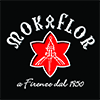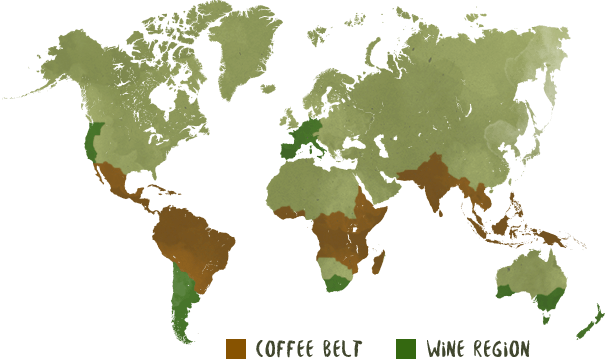Coffee and wine: about the differences and similarities
The Specialty Coffee movement, or so-called “Third Wave”, which is increasing more and more even in Italy, honors coffee as an artistic and handmade product. The outstanding quality in all its steps is to be maintained through the entire production, from the farm to the finished cup of coffee.
Althought this is not always easy, we try to diffuse this concept and knowledge through our blog, in our courses and bars.
For a better understanding of Specialty coffees, one often refers to the cultivation and production of wine: a beverage that has made tremendous progress in the recent years in expanding and consciously acquiring the knowledge of the aromatic quality that each bottle contains. This benefits the professionals and end customers, who are becoming increasingly demanding and knowledgeable.
Sommelier courses, guided wine tastings, wine bars or local sales promotions such as “open wine cellars” have helped the raise public awareness about wine, making people realize that there is not only the difference between white or red wine.
This development in the world of coffee, especially in Italy, is the first step. Learning about and knowing about the product are things that every professional needs to know first and foremost in order to convey the knowledge of the quality of each coffee cup to the consumer.
The new generation of Baristas needs to be well trained and educated in order to offer the most different variations of coffee, mixed or pure, as well as the various processing methods, while being able to tell something about them. Thanks to this, customers can have a look at the coffee menu, much like the wine menu.
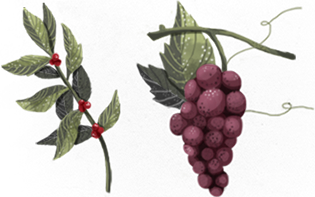
Of course, both drinks come from a plant: the grape and the drupa (or even coffee cherry) are nothing but the fruits of the grapevine or the coffee bush and their cultivation is a mixture of art and science.
With coffee there are a large number of different varieties (Bourbon, Typica, Caturra, Catuai, SI28, …). The same happens with wine. The different grape varieties (Sangiovese, Malvasia, Ribolla, Pinot, Merlot, …) all have different tastes.
The aromatic characteristics and the taste depend both on the coffee and on the wine, on the height, the climate and the soil on which the coffee or wine plants grow. So it can happen that, even though we are speaking about the same variety, but cultivated in two different regions on our planet, the results produced can be very different. For example, a finished cup of bourbon from Brazil provides a very different taste experience than an African bourbon grown in Burundi.
Likewise, a Chardonnay from Friuli is very different from one that comes from Sicily, although they both grow on the Italian peninsula. The wine producers use the word “terroir” to describe how this phenomenon affects growing, which is just as applicable to the coffee.
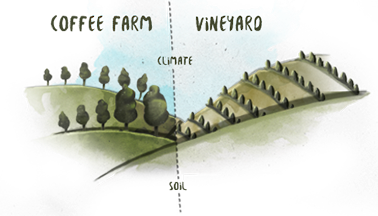
The label of a Specialty coffee is similar to that of a good wine: name of the farm, area of growth, variety, height and possible certification (Organic, Fair Trade, UTZ, …) and not least the flavor description, which is indispensable to facilitate the customer’s choice.
To process the coffee plants, the natural method can be compared with the cultivation of red wine. The shell of the grape is left in the must during fermentation. This is a reason why the naturally grown coffees are often sweeter, fruity and rounder.
The washed method, which gives the coffee more freshness and acidity, on the other hand can be similar to that used for white wine: the shell is immediately sorted out or removed during fermentation.
And what about the tasting? Well, this process is almost identical. The coffee tasters use the same method as the wine sommeliers to determine the characteristics.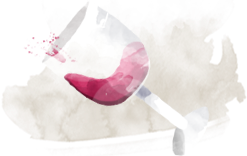
The beverage is swirled in a glass or cup to expose the liquid to a larger amount of oxygen. This is essential so that all flavors can develop in the best possible way.
Hold your nose to the glass or cup and inhale deeply to feel all the aromas.
The beverage is swirled in a glass or cup to expose the liquid to a larger amount of oxygen. This is essential so that all flavors can develop in the best possible way.
Hold your nose to the glass or cup and inhale deeply to feel all the aromas.
Take a small sip of the drink, trying to re-enrich the drink with oxygen in order to allow the aroma to emerge in the best way.
One spits out to avoid excessive consumption of alcohol or caffeine.
Also the aromas which you can taste are similar when speaking about coffee and wine: chocolate, fruity, spicy, flowery, nutty, grassy, sour, sweet, …
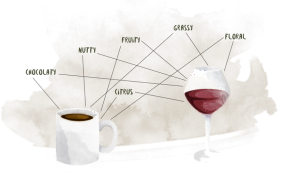
Author: Simone Celli, ilcaffeespressoitaliano.com
